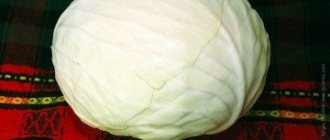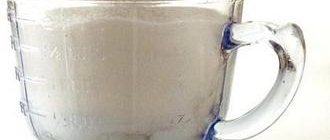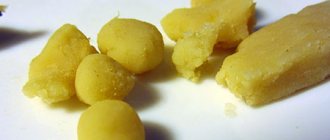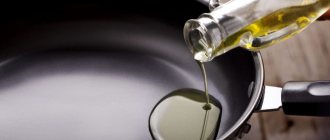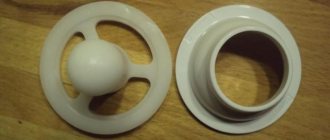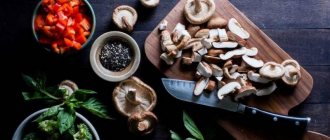- August 11, 2019
- Multicooker Recipes
- Ekaterina Gorbatova
Sooner or later, each of us, inspired by foreign shows, decides on a feat in the kitchen, finds a stunning exotic recipe in English and falls into a stupor at the sight of unfamiliar measures of weight and volume. How to figure it out, tbsp in cooking - what is it? And how is this different from tsp? But in fact, everything is very simple. These are just spoons, a tablespoon and a teaspoon, which are used to measure the required amount of bulk or liquid products.
How many grams are in a milliliter of rice?
Mass is a characteristic of a body, which is a measure of gravitational interaction with other bodies.
Volume is a quantitative characteristic of the space occupied by a body, structure or substance.
Density is a physical quantity defined as the ratio of body mass to body volume.
The relationship between milliliters and grams of rice is determined by a simple mathematical formula:
V—volume; m—mass; p—density.
In the calculation, the density of rice = 750 kg/m3 was taken.
The density of rice can vary depending on temperature and pressure. You can find the exact density of rice in reference books.
See also the universal program for converting milliliters to grams for any substance depending on its density.
If you need to convert m3 to tons, then see the program for converting tons to m3.
If you need to convert kg to m3, then see the program for converting kg to m3.
If you need to convert liters to kg, then see the program for converting liters to kg.
Question: How many grams are in a milliliter of rice?
Answer: 1 g of rice is equal to 1.333 milliliters.
Question: How many milliliters are in a gram of rice?
Answer: 1 milliliter (ml) of rice is equal to 0.75 grams (g).
You can quickly solve this simple mathematical operation using our online program. To do this, enter the initial value in the appropriate field and click the button.
This page provides the simplest program for converting grams of rice to milliliters. With this online calculator you can convert milliliters of rice to grams (ml to g) and vice versa in one click.
Depending on the processing, milled, polished and crushed rice are distinguished.
- Polished - has a rough surface: hulled rice grains processed on grinding machines.
- Polished - has a smooth shiny surface of glassy rice varieties, processed on special machines.
- Broken rice - does not consist of whole kernels, but is a by-product of rice processing.
How to weigh flour without scales
Not every housewife has a device for measuring the mass of food in her kitchen, however, people cope well even with very complex recipes. In order to weigh out the required portion, you can use vessels or spoons: dessert, table, tea. With one of these items on hand, you can easily get the grain you need for baking.
How many tablespoons in a glass of flour
Depends on the type and content. If the faceted one contains 130-160 g, then it will contain 4.5-5 tbsp. l. with a hat. There are five of them in the teahouse. If you take a level spoon from the first, you get from six and a half to eight. If you use tea, then 8. Many people do not understand how to measure 100 grams of flour without having a measuring device at hand. It's very simple: take 5 tbsp. l. without a slide or 3.5 with it. Now you know how many tablespoons are in 100 grams of flour.
If you have a faceted glass, then to get 100 g you need to pour so much so that the flour does not reach the rim by about a centimeter. There is another way. Sprinkle flour a little at a time, compacting it. To do this, after each new portion you need to carefully hit the dishes on the table. Get the tallest hat you can. You will get approximately 200-210 g. Then, from the resulting volume, separate approximately half by eye. This will be 100 g.
How many glasses in a kilogram of flour
If you have a lot of grain product, then it is easy to divide it into portions. To do this, you need to have an idea of how many glasses of flour are in 1 kg. Keeping all the above information in mind, it is very easy to draw a conclusion. If you don't know how to measure flour without a kitchen scale, use a cut glass. If you fill to the rim, you will get 7.5-8 units, depending on the density of the grain product and the level of humidity. If you fill the container to the top, you will get 6-6.5 pieces. In the case of tea, the quantity will be the same when filled to the rim.
How much rice in one glass
How do glasses differ:
- A faceted (thick-walled) standard glass holds 200 ml.
- a tea (thin-walled) glass has a volume of 250 ml;
A faceted glass filled to the brim (200 ml) contains:
- 180 g dry rice;
- 330 g cooked rice.
If a glass (200 ml) is filled to the rim, the rice will be:
A tea glass filled to the brim (250 ml) contains:
- 230 g dry rice;
- 400 g boiled rice.
If a glass (250 ml) is filled to the rim, the rice will be:
Measuring powder without scales
Various culinary recipes mention a variety of measurements for powder: a tablespoon or teaspoon, a glass, grams. To avoid confusion, you need to choose a specific size for yourself and convert all weight categories to one measurement. It is more convenient to use the dining room and tea room.
Even using the same recipe, several housewives end up with dishes that are quite different in taste and appearance. Therefore, it is advisable to remember the most successful masterpiece in order to decide how much flour powder should be put into a spoon.
When mentioning a glass, they usually mean the standard Soviet glass container, which holds exactly 250 ml of water if poured full. A glass filled to the rim holds 200 ml. If the flour is poured flush with the edges, its weight is approximately 160 g, if along the rim - 130 g.
When you need to measure 500 g of a substance, it is not very convenient to count using utensils or glasses. Therefore, savvy housewives use the following method:
- purchase a paper kilogram bag of any type of product in a store;
- measure the height of the packaging with a ruler;
- divide the result in half, marking the strip directly on the bag;
- carefully cut the package along the intended line;
- Now each half contains approximately the same amount of the component - half a kilo.
It is convenient to use a special plastic transparent cup, on the wall of which there are weight measures of common products: flour, sugar, salt, water. But it is also advisable to fill such a container with the substance on top, rather than scooping the product from a bag or jar.
Late ripening varieties
Late-ripening varieties of carrots are represented by a mass of root crops from 120 grams and above.
- "Queen of Autumn". It ripens in 4 to 4.5 months and gains a weight of root crops of approximately 160 g.
- "Flakke." Suitable a little earlier - after 3.5-4 months. Root vegetables are quite long, weighing from 150 to 170 g per piece.
- "Emperor". The variety has large fruits up to 30 cm long, weighing 200 g.
- "Flaccoro." It is not inferior to the previous variety; on the contrary, it exceeds it in length - up to 39 cm, but the weight remains the same.
- "Yellowstone". Large vegetables similar in appearance to a spindle. The fruit harvest is 20-25 cm in length, almost every carrot weighs 200 g.
- "Leander". The vegetables are large, the weight of the root crop reaches 10 g.
- "Scarla." Another variety with giant root crops - about 300 g.
- "Tinga F1". Although the vegetables are long, their weight is no more than 120 g.
- "Totem F1". A hybrid with a carrot weight of about 150 grams.
- "Chantenay 2461." Thick, short root vegetables. In terms of weight, it can be considered a champion among all the listed varieties and hybrids - from 250 to 500 g.
How much to weigh in grams
Everything would be fine, but most often you need not 160 or 25 grams. Usually, recipes use “round” numbers. This is where the question arises, for example, how to measure 100 grams of flour?
The easiest way is to pour out an extra 30 or 60 grams from a glass (depending on the glass) “by eye”, that is, 100 grams will be a little more than half a tea glass and a little less than half a cut glass. You can put 4 level tablespoons. There is a more cunning way. It will require us time and some simple devices.
So, we need a ruler and a blank sheet of paper. On a sheet of paper we draw a rectangle 10 by 20 centimeters. On the larger sides (20 cm) we measure 2 cm, put dots and connect them with lines. Before us is a rectangle 10 by 2 cm. Right?
Pour a kilogram of flour onto the paper. We distribute it evenly over a larger rectangle, the one we drew at the beginning (20x10 cm). Make sure that the flour does not extend beyond the rectangle. Then carefully use a knife to separate the part that occupies a smaller rectangle (10x2 cm). This is 100 g.
We do the same thing when we don’t know how to measure 200 grams of flour. Only then do we measure on the 20-centimeter side not 2, but 4 cm. Next, do the same according to the algorithm. By the way, this method is also suitable for measuring sugar or cereals.
Very often, many culinary recipes indicate the exact amount of an ingredient needed to prepare a dish. But not every housewife has special kitchen scales in her kitchen.
If such equipment is not available in your home, do not despair. You can measure the required amount using a teaspoon, dessert or tablespoon.
Note!
But it is worth considering that the quantity will depend on the component itself. It all depends on the severity and density of the ingredient. Therefore, cutlery filled with different components will weigh differently.
A tablespoon is a cutlery. Its volume is 18 milliliters. This cutlery is used for eating porridge, first courses or other liquid culinary delights.
If you need to weigh a particular product, you should take into account the density of the ingredient and the “load” of the cutlery. The weight with and without a slide will vary from 4 to 6 grams.
The most common ingredients in the kitchen required to prepare a dish are sugar, flour and salt. Therefore, it is necessary to know the measurements of these products.
Table: measure of measurement.
Table: measures of other ingredients necessary for cooking.
| How many grams are in cutlery | Without slide (in gr.) | With a slide (in gr.) |
| Baking powder | 15 | 20 |
| Raisins | 15 | 20 |
| Dried mushrooms | 10 | 15 |
| Milk | 18 | 24 |
| Powdered milk | 20 | 25 |
| Cream | 14 | 18 |
| Tea | 6 | 11 |
| Citric acid | 25 | 30 |
| Jam | 18 | 24 |
| Protein | 15 | 19 |
| Rice | 25 | 30 |
| Perlovki | 25 | 30 |
| Millet cereal | 25 | 30 |
| Wheat cereal | 25 | 30 |
| Wheat flakes | 9 | 15 |
| Corn grits | 25 | 30 |
| Barley groats | 25 | 30 |
| Sago grains | 20 | 25 |
| Beans | 30 | 35 |
| Peas | 25 | 30 |
| Powdered sugar | 25 | 30 |
| Sunflower oil | 25 | 30 |
| Buckwheat | 25 | 30 |
| butter | 25 | 30 |
| Flax seeds | 16 | 23 |
| Tomato paste | 30 | 35 |
| Bran | 4,5 | 7 |
| Lentils | 25 | 30 |
| Hercules | 12 | 18 |
| poppy | 18 | 23 |
| Condensed milk | 48 | 55 |
| Copper sulfate | 65 | 75 |
| Flaxseed oil | 25 | 30 |
| Cottage cheese | 40 | 47 |
| Cinnamon | 20 | 25 |
| Coffee | 20 | 25 |
| Vinegar | 16 | 21 |
| Cocoa | 15 | 20 |
| Oatmeal | 12 | 18 |
| Liqueur | 20 | 25 |
| Corn flakes | 7 | 13 |
| Mayonnaise | 45 | 50 |
| Ground crackers | 15 | 20 |
| Oatmeal | 18 | 22 |
| Monkey | 30 | 35 |
| Gelatin | 15 | 20 |
| Water | 18 | 23 |
| Soda | 29 | 35 |
| Starch | 12 | 15 |
| Sour cream | 18 | 24 |
| Egg powder | 16 | 20 |
| Dry yeast | 16 | 20 |
| Fresh yeast | 45 | 55 |
| Vegetable oil | 25 | 30 |
| Ghee | 25 | 30 |
| Melted margarine | 20 | 25 |
| Ground black pepper | 12 | 15 |
| Rye flour | 25 | 30 |
| Ground walnuts | 30 | 35 |
| Ground peanuts | 25 | 30 |
| Ground hazelnuts | 30 | 35 |
| Ground almonds | 30 | 35 |
Honey is often used in many dishes. This is a very allergenic product, so it is worth knowing how many grams of honey are in a tablespoon so as not to exceed its permitted dose. One spoon contains 30 g. honey, provided that it is of liquid consistency.
Tables like these help in the kitchen. They relieve women from the need to purchase unnecessary kitchen appliances and clutter up the kitchen space. This significantly saves a woman’s time, physical effort and financial resources.
How to measure 100 g of flour using geometry
Many effective ways have been invented and tested to measure more or less accurately 100 g of flour needed for a recipe:
- Fill 5 standard spoons: 5x 20 g = 100 g. The method is most often used.
- Pour 1 kg of flour product into a measuring container with vertical transparent walls. Measure the height of the filled composition and divide the value into 10 parts. Use a felt-tip pen to make lines that are clearly visible. Pour the flour into 1 division - this will be the required 100 g of product.
- Use a faceted glass, pouring 2/3 of the powder into it.
- Lay out a sheet of thick paper on the table and draw a rectangle measuring 10x20 cm on it. Make edges 2-3 cm high along the edges. Draw a distance of 2 cm from the edge with a figure width of 10 cm. Distribute 1 kg of flour over the plane, keeping the surface flat without elevations and depressions Use a knife or spatula to separate part of the product along the drawn line. This amount of component corresponds to the weight of 100 g.
Even without a kitchen scale, you can always find a way to measure the right amount of flour according to the chosen recipe. The main thing is to show ingenuity and intelligence. When preparing food at home, it is advisable to have permanent measuring containers, with which you can conveniently and more or less accurately measure the weight of the ingredients specified in the recipe.
Wheat flour is a product obtained from wheat grains, the most popular type of flour used for baking. Wheat baking flour in Russia is divided into semolina, wallpaper, premium, first and second grades.
Premium flour or Extra flour has quite a bit of gluten (at least 28% according to GOST), it has a pure white color, is used for baked goods, and is often used as a thickener in sauces.
First grade flour is used for savory baked goods; products made from it go stale more slowly; this is the main flour for baking bread.
Second-grade flour contains up to 8% bran, so it is much darker than first-grade flour; it is used to make soft products and white bread, and when mixed with rye flour, black bread is made.
So-called “whole grain products” are baked from wallpaper flour; due to the presence of bran in such flour, products made from it have a higher content of fiber and B vitamins than products made from higher grades of flour. Graham flour is historically the first type of wheat flour, popularized in the first half of the 19th century in the USA and Western Europe for nutritional purposes.
How much flour can a faceted glass or cup hold?
Bulk products weigh less than water in containers of the same volume. According to the table of weights and measures, a 250 ml glass contains 155-160 g of flour powder. These tables were obtained experimentally, and even experienced chefs adhere to generally accepted values when preparing food.
If we average the weight of the powder in a small heaped canteen, we get 20 g of bulk product. This means that an ordinary faceted glass (without a smooth rim) holds 6.5 (130 g) tablespoons of premium flour substance (wheat).
American or English cuisine operates with cups, the volume of which is 250 ml, and the weight of the product is 160 g. By arithmetic we calculate: 160 g divided by 20 g. As a result, the cup holds 8 tbsp. spoons of flour product.
Weighing using improvised containers has a measurement error of about 10%. If very precise adherence to the weight category is required, it is recommended to use a kitchen scale.
